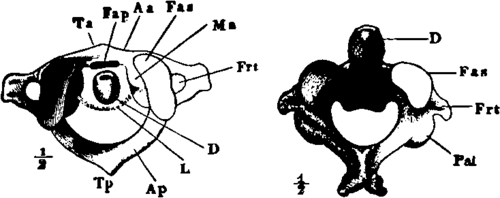The Atlas And Axis
Description
This section is from the book "The Human Body: An Elementary Text-Book Of Anatomy, Physiology, And Hygiene", by H. Newell Martin. Also available from Amazon: The Human Body.
The Atlas And Axis
The first and second cervical vertebrę differ considerably from the others. The first, called the atlas (Fig. 13), carries the head; it has a very small body and a very large neural ring. A ligament, L, divides the ring into a ventral and a dorsal portion; the spinal cord passes through the latter and a bony peg, D, lies in the former. The peg is the odontoid or tooth-like process. This reaches up from the second cervical or axis vertebra (Fig. 14) and forms a pivot around which the atlas, carrying the skull with it, rotates when the head is turned from side to side.

Fig. 13. The atlas.
Fig. 14. The axis. Aa, body of atlas. D, odontoid process of axis; Fas, facet on upper side of atlas with which the skull articulates; and in Fig. 13, anterior articular surface of axis; L, transverse ligament; Frt, vertebral foramen.
How are the intervertebral foramina formed? What is their purpose?
What is the first cervical vertebra called? Describe its general form. How is its neural ring divided? What lies in each division? What is the second cervical vertebra named? What is the odontoid process? Around what pivot does the head rotate when the face is turned on either side?
On the anterior (upper) surface of the atlas are a pair of shallow hollows, Fas; into these fit a pair of knobs, found towards the back of the under surface of the skull (Fig. 20), which glide in the hollows during nodding movements of the head.
Continue to:
